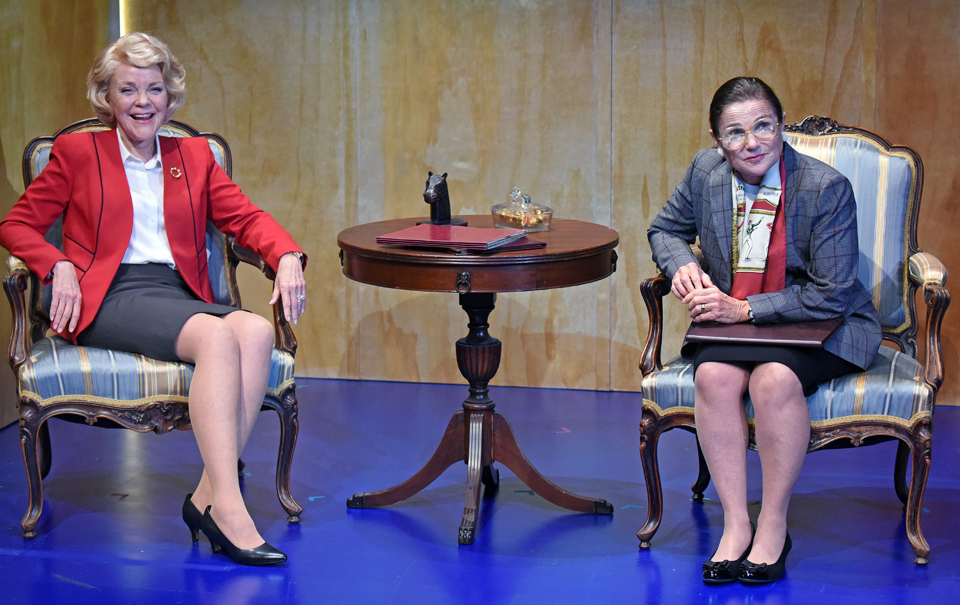
BEVERLY HILLS, Calif.—There’s no question about it. The Wallis Annenberg Center for the Performing Arts has truly become a Westside L.A. destination for culture, making unnecessary an often harrowing journey to downtown L.A. Its current offering, the West Coast premiere of Sisters in Law, stars Stephanie Faracy as Sandra Day O’Connor and Tovah Feldshuh as Ruth Bader Ginsburg, the first two women appointed as Justices of the Supreme Court of the United States, in 1981 and 1993 respectively. It’s a hit.
Written by Jonathan Shapiro, a lawyer turned TV writer and producer and now playwright, Sisters in Law is based on Linda Hirshman’s New York Times bestseller. For an intermissionless 90 minutes, the play celebrates both friendship and conflict as the first two female justices pick their way through the centuries-old hurdles of gender-biased precedent and tradition. Directed by Patricia McGregor (who also helmed the powerful Skeleton Crew), Sisters in Law appropriately features an all-female design team.
Appointed by President Bill Clinton, the Notorious RBG has become a cultural icon and national living treasure as a feminist fighter for ever expanding democratic rights. She has been the subject of numerous books, as well as a traveling museum exhibition, a documentary and a biopic feature film. Having successfully traversed through several episodes of recurring cancer, RBG is the subject of millions of Americans’ prayers for many more years of good health—at least until a newly elected Democrat in the White House can appoint her replacement!
Sandra Day O’Connor, the first woman on the Court, rarely played a leading role for any particular cause. Fulfilling a campaign promise, President Reagan appointed her, and the U.S. Senate confirmed her unanimously. Expected to be a reliable conservative vote, the former Arizona state senator sometimes confounded court-watchers by waffling on a number of critical issues (reproductive rights, for example). As Republican appointees grew not only in number but in ideological fervor through the Reagan and Bush Sr. years, she became more of a centrist. Bush Jr. “corrected” her centrist leanings with his appointment of the far more reactionary Samuel Alito as her replacement.
The play clearly brings out not just O’Connor willy-nilly falling into the center, but actively seeking to play a role from the center. The center, she felt, is where the action takes place, representing not the right or left fringe, but more closely where the American public was prepared at any given moment to accept gradual, incremental, albeit incomplete change. By contrast, her only “sister” on the court came out of the ACLU and the women’s movement and sought to make bold, affirmative, life-altering advances in the law of the land whenever the opportunity presented itself.
Although only three years apart in age, O’Connor and Ginsburg came from very different worlds. Shapiro spends a good deal of his time delineating those worlds, which exerted so powerful an influence on the two women. On the one hand, the Phoenix, Arizona, Republican churchgoing society club woman with utterly conventional values, raised to rope and ride on the Lazy-B Ranch under a father who enjoyed nothing more than barbecuing up a batch of bull’s balls. She bore up against assaults on her gender with the forbearance typical of her time and class and retired from the Court after 24 years because she felt her aging husband needed her home. On the other, the impatient litigious New York Jewish opera-loving radical intellectual firecracker with an adoring husband who cooked a gourmet dinner every night in order to give her the freedom to become her most fulfilled self.
Where O’Connor sought not to fix things but to uphold the law as she saw it, compromising principle in the face of realism, Ginsburg, called “Mother of the Feminist Movement,” was out to change the law, elevating egalitarian principle above settling for half-measures. Yet if sisterhood would be powerful, they needed each other, even if one moved at the pace of a tortoise and the other a hare. They both found solace and comfort in the feminism of the Biblical Book of Ruth, which they could quote by heart. And they could both see the sorry truth in SDO’s observation that “When it comes to gender equality, liberal men are in no hurry.”
After SDO left the Court, Ginsburg remained the sole woman for a number of years, suffering the obnoxious sexism of her colleagues. At least with SDO there, because of her class and seniority, they felt the need at least not to disappoint her. With her gone, they did not feel the same way toward the “pushy” RBG.
The different approaches to law that the playwright educes from their life experiences and the court cases under their review reveal much about the deep divide in our country today, and also about the hope for some degree of agreement that overcomes partisanship. The play ends in 2012 when O’Connor joins the now three women on the Court (after two female appointments by President Obama) in a historic reunion. It concludes with much optimism that if Obama is re-elected that year the Court will be poised to enjoy a lasting liberal majority that will, in the character Ginsburg’s words, allow the Court to “write the laws that allow people to live the kind of life they want.”
Shapiro clearly weights the argument of his play on RBG’s side, not contesting her assessment that “Sandra didn’t grow, but she didn’t grow bitter either.” At the same time, he highlights how gratuitous she could be. When SDO admirably admits that she made mistakes in her career, RBG taunts her saying, “I try not to make mistakes to begin with.”

Sisters in Law fits the genre of biopic plays, condensing some 30 years of history into a taut hour and a half. Obviously much is left out, but typically for this kind of theatrical treatment, the key touchstones are ticked off: for SDO, the cowgirl, the hair, the dutiful wife, the story about the bull balls, an anecdote or two about her terms as state senator and judge. And for RBG, the love of music, the adoring supportive husband, the oddly mutual friendship with fellow Justice Antonin Scalia, the bouts with cancer, the exercise routine, the famous collars. There’s very little if anything about the women’s children.
Director Patricia McGregor exploits the script for every nuance. The text bristles with suppressed rage, humor both intentional and not, and levels of cool-to-warm feeling as the two women grow to understand and appreciate one another, even as they continue to disagree and vote differently on many decisions. Sister in Law’s all-female design team includes scenic designer Rachel Myers, who has a kinetic sense of space constantly changing settings between offices (hers and hers) and homes (hers and hers). A crew of personal assistants to the two lead actors, doubling as stagehands, busy themselves fluidly moving props around, but I didn’t see these efficient women and men named in the program.
Costume designer Melissa Trn convincingly captures each woman’s sense of style and propriety, lighting designer Leigh Allen and sound designer Cricket Myers do their work splendidly. Projections by Yee Eun Nam bring us into the period and space as the decades unfold. Hair and wig design by Judi Lewin brings out the hairspray helmet esthetic of Justice O’Connor by contrast to the neatly beribboned, utilitarian ponytail for RBG.
Sisters in Law had a previous run in Phoenix and is now slated to move on to New York. After the performance I attended (Sept. 26), the audience rose as one in glorious approval.
Radio station KUSC’s Arts Alive contributor Tim Greiving spoke to the director, Patricia McGregor. Their 11-minute interview can be accessed here. He also spoke with author Jonathan Shapiro for 13 minutes about the play here.
Sisters in Law runs through Sun., Oct. 13, playing weekdays at 8 p.m., Sat. at 2:30 and 8 p.m., and Sun. at 2:30 and 7:30 p.m. There will be no performance on Oct. 8. The Wallis Annenberg Center for the Performing Arts is located at 9390 N. Santa Monica Blvd., Beverly Hills 90210. For tickets and information call (310) 746-4000, go to TheWallis.org/Sisters, or visit the box office at the theatre.












Comments